Gen3dlife Journals Results

Computer Graphics Forum, Vol. 37, Num. 2, pp 101--110, 2018.
DOI: http://dx.doi.org/10.1111/cgf.13345
DOI: http://dx.doi.org/10.1111/cgf.13345
BibTeX

Despite recent advances in surveying techniques, publicly available Digital Elevation Models (DEMs) of terrains are lowresolution except for selected places on Earth. In this paper we present a new method to turn low-resolution DEMs into plausible and faithful high-resolution terrains. Unlike other approaches for terrain synthesis/amplification (fractal noise, hydraulic and thermal erosion, multi-resolution dictionaries), we benefit from high-resolution aerial images to produce highly-detailed DEMs mimicking the features of the real terrain. We explore different architectures for Fully Convolutional Neural Networks to learn upsampling patterns for DEMs from detailed training sets (high-resolution DEMs and orthophotos), yielding up to one order of magnitude more resolution. Our comparative results show that our method outperforms competing data amplification approaches in terms of elevation accuracy and terrain plausibility.

Computers & Graphics, Vol. 71, pp 23 - 34, 2018.
DOI: http://dx.doi.org/10.1016/j.cag.2017.11.004
DOI: http://dx.doi.org/10.1016/j.cag.2017.11.004
BibTeX

The visual enrichment of digital terrain models with plausible synthetic detail requires the segmentation of aerial images into a suitable collection of categories. In this paper we present a complete pipeline for segmenting high-resolution aerial images into a user-defined set of categories distinguishing e.g. terrain, sand, snow, water, and different types of vegetation. This segmentation-for-synthesis problem implies that per-pixel categories must be established according to the algorithms chosen for rendering the synthetic detail. This precludes the definition of a universal set of labels and hinders the construction of large training sets. Since artists might choose to add new categories on the fly, the whole pipeline must be robust against unbalanced datasets, and fast on both training and inference. Under these constraints, we analyze the contribution of common per-pixel descriptors, and compare the performance of state-of-the-art supervised learning algorithms. We report the findings of two user studies. The first one was conducted to analyze human accuracy when manually labeling aerial images. The second user study compares detailed terrains built using different segmentation strategies, including official land cover maps. These studies demonstrate that our approach can be used to turn digital elevation models into fully-featured, detailed terrains with minimal authoring efforts.

Computers & Graphics, Vol. 73, pp 1--16, 2018.
DOI: http://dx.doi.org/10.1016/j.cag.2018.02.007
DOI: http://dx.doi.org/10.1016/j.cag.2018.02.007
BibTeX

Mobile devices have experienced an incredible market penetration in the last decade. Currently, medium to premium smartphones
are relatively a
ordable devices. With the increase in screen size and resolution, together with the improvements in performance of
mobile CPUs and GPUs, more tasks have become possible. In this paper we explore the rendering of medium to large volumetric
models on mobile and low performance devices in general. To do so, we present a progressive ray casting method that is able to
obtain interactive frame rates and high quality results for models that not long ago were only supported by desktop computers.

Coherent multi-layer landscape synthesis
The Visual Computer, Vol. 33, Num. 6, pp 1005--1015, 2017.
DOI: http://dx.doi.org/10.1007/s00371-017-1393-6
DOI: http://dx.doi.org/10.1007/s00371-017-1393-6
BibTeX

We present an efficient method for generating coherent multi-layer landscapes. We use a dictionary built from exemplars to synthesize high-resolution fully featured terrains from input low-resolution elevation data. Our example-based method consists in analyzing real-world terrain examples and learning the procedural rules directly from these inputs. We take into account not only the elevation of the terrain, but also additional layers such as the slope, orientation, drainage area, the density and distribution of vegetation, and the soil type. By increasing the variety of terrain exemplars, our method allows the user to synthesize and control different types of landscapes and biomes, such as temperate or rain forests, arid deserts and mountains.

Neurogastroenterology and Motility, Vol. 29, Num. 2, pp 12930-1--12930-8, 2017.
DOI: http://dx.doi.org/10.1111/nmo.12930
DOI: http://dx.doi.org/10.1111/nmo.12930
BibTeX

Background:
The metabolic activity of colonic microbiota is influenced by diet; however, the relationship between metabolism and colonic content is not known. Our aim was to determine the effect of meals, defecation, and diet on colonic content.
Methods:
In 10 healthy subjects, two abdominal MRI scans were acquired during fasting, 1 week apart, and after 3 days on low- and high-residue diets, respectively. With each diet, daily fecal output and the number of daytime anal gas evacuations were measured. On the first study day, a second scan was acquired 4 hours after a test meal (n=6) or after 4 hours with nil ingestion (n=4). On the second study day, a scan was also acquired after a spontaneous bowel movement.
Results:
On the low-residue diet, daily fecal volume averaged 145 ± 15 mL; subjects passed 10.6 ± 1.6 daytime anal gas evacuations and, by the third day, non-gaseous colonic content was 479 ± 36 mL. The high-residue diet increased the three parameters to 16.5 ± 2.9 anal gas evacuations, 223 ± 19 mL fecal output, and 616 ± 55 mL non-gaseous colonic content (P<.05 vs low-residue diet for all). On the low-residue diet, non-gaseous content in the right colon had increased by 41 ± 11 mL, 4 hours after the test meal, whereas no significant change was observed after 4-hour fast (-15 ± 8 mL; P=.006 vs fed). Defecation significantly reduced the non-gaseous content in distal colonic segments.
Conclusion & inferences:
Colonic content exhibits physiologic variations with an approximate 1/3 daily turnover produced by meals and defecation, superimposed over diet-related day-to-day variations.

Error-aware Construction and Rendering of Multi-scan Panoramas from Massive Point Clouds
Computer Vision and Image Understanding, Vol. 157, pp 43--54, 2017.
DOI: http://dx.doi.org/10.1016/j.cviu.2016.09.011
DOI: http://dx.doi.org/10.1016/j.cviu.2016.09.011
BibTeX

Obtaining 3D realistic models of urban scenes from accurate range data is nowadays an important research topic, with applications in a variety of fields ranging from Cultural Heritage and digital 3D archiving to monitoring of public works. Processing massive point clouds acquired from laser scanners involves a number of challenges, from data management to noise removal, model compression and interactive visualization and inspection. In this paper, we present a new methodology for the reconstruction of 3D scenes from massive point clouds coming from range lidar sensors. Our proposal includes a panorama-based compact reconstruction where colors and normals are estimated robustly through an error-aware algorithm that takes into account the variance of expected errors in depth measurements. Our representation supports efficient, GPU-based visualization with advanced lighting effects. We discuss the proposed algorithms in a practical application on urban and historical preservation, described by a massive point cloud of 3.5 billion points. We show that we can achieve compression rates higher than 97% with good visual quality during interactive inspections.

The Visual Computer, Vol. 33, Num. 1, pp 47-61, 2017.
DOI: http://dx.doi.org/10.1007/s00371-015-1151-6
DOI: http://dx.doi.org/10.1007/s00371-015-1151-6
BibTeX

Throughout the years, many shading techniques have been developed to improve the conveying of information in volume visualization. Some of these methods, usually referred to as realistic, are supposed to provide better cues for the understanding of volume data sets. While shading approaches are heavily exploited in traditional monoscopic setups, no previous study has analyzed the effect of these techniques in virtual reality. To further explore the influence of shading on the understanding of volume data in such environments, we carried out a user study in a desktop-based stereoscopic setup. The goals of the study were to investigate the impact of well-known shading approaches and the influence of real illumination on depth perception. Participants had to perform three different perceptual tasks when exposed to static visual stimuli. 45 participants took part in the study, giving us 1152 trials for each task. Results show that advanced shading techniques improve depth perception in stereoscopic volume visualization. As well, external lighting does not affect depth perception when these shading methods are applied. As a result, we derive some guidelines that may help the researchers when selecting illumination models for stereoscopic rendering.
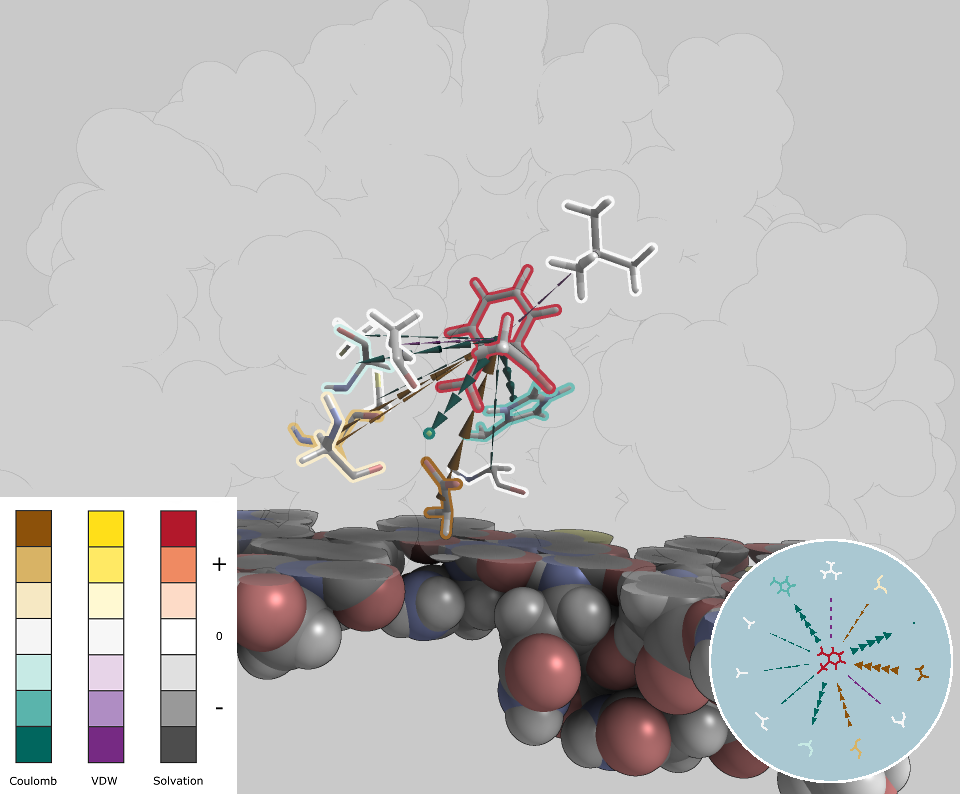
IEEE Transactions on Visualization and Computer Graphics, Vol. 23, Num. 1, pp 731--740, 2017.
DOI: http://dx.doi.org/10.1109/TVCG.2016.2598825
DOI: http://dx.doi.org/10.1109/TVCG.2016.2598825
BibTeX

Molecular simulations are used in many areas of biotechnology, such as drug design and enzyme engineering. Despite the development of automatic computational protocols, analysis of molecular interactions is still a major aspect where human comprehension and intuition are key to accelerate, analyze, and propose modifications to the molecule of interest. Most visualization algorithms help the users by providing an accurate depiction of the spatial arrangement: the atoms involved in inter-molecular contacts. There are few tools that provide visual information on the forces governing molecular docking. However, these tools, commonly restricted to close interaction between atoms, do not consider whole simulation paths, long-range distances and, importantly, do not provide visual cues for a quick and intuitive comprehension of the energy functions (modeling intermolecular interactions) involved. In this paper, we propose visualizations designed to enable the characterization of interaction forces by taking into account several relevant variables such as molecule-ligand distance and the energy function, which is essential to understand binding affinities. We put emphasis on mapping molecular docking paths obtained from Molecular Dynamics or Monte Carlo simulations, and provide time-dependent visualizations for different energy components and particle resolutions: atoms, groups or residues. The presented visualizations have the potential to support domain experts in a more efficient drug or enzyme design process.

The Visual Computer, Vol. 33, Num. 6, pp 869--881, 2017.
DOI: http://dx.doi.org/10.1007/s00371-017-1397-2
DOI: http://dx.doi.org/10.1007/s00371-017-1397-2
BibTeX

The Solvent Excluded Surface (SES) is a popular molecular representation that gives the boundary of the molecular volume with respect to a specific solvent. SESs depict which areas of a molecule are accessible by a specific solvent, which is represented as a spherical probe. Despite the popularity of SESs, their generation is still a compute-intensive process, which is often performed in a preprocessing stage prior to the actual rendering (except for small models). For dynamic data or varying probe radii, however, such a preprocessing is not feasible as it prevents interactive visual analysis. Thus, we present a novel approach for the on-the-fly generation of SESs, a highly parallelizable, grid-based algorithm where the SES is rendered using ray-marching. By exploiting modern GPUs, we are able to rapidly generate SESs directly within the mapping stage of the visualization pipeline. Our algorithm can be applied to large time-varying molecules and is scalable, as it can progressively refine the SES if GPU capabilities are insufficient. In this paper, we show how our algorithm is realized and how smooth transitions are achieved during progressive refinement. We further show visual results obtained from real world data and discuss the performance obtained, which improves upon previous techniques in both the size of the molecules that can be handled and the resulting frame rate.

Computer-Aided Design, Vol. 79, pp 48--59, 2016.
DOI: http://dx.doi.org/10.1016/j.cad.2016.06.005
DOI: http://dx.doi.org/10.1016/j.cad.2016.06.005
BibTeX

The use of virtual prototypes and digital models containing thousands
of individual objects is commonplace in complex industrial
applications like the cooperative design of huge ships. Designers are
interested in selecting and editing specific sets of objects during
the interactive inspection sessions. This is however not supported by
standard visualization systems for huge models. In this paper we discuss in detail
the concept of rendering front in multiresolution trees, their properties and the
algorithms that construct the hierarchy and efficiently render it,
applied to very complex CAD models, so that the model structure and
the identities of objects are preserved. We also
propose an algorithm for the interactive inspection of huge
models which uses a rendering budget and supports selection of
individual objects and sets of objects, displacement of the selected
objects and real-time collision detection during these
displacements. Our solution ---based on the analysis of several existing
view-dependent visualization schemes--- uses a Hybrid Multiresolution Tree that
mixes layers of exact geometry, simplified models and impostors, together with a
time-critical, view-dependent algorithm and a Constrained Front.
The algorithm has been
successfully tested in real industrial environments; the models
involved are presented and discussed in the paper.
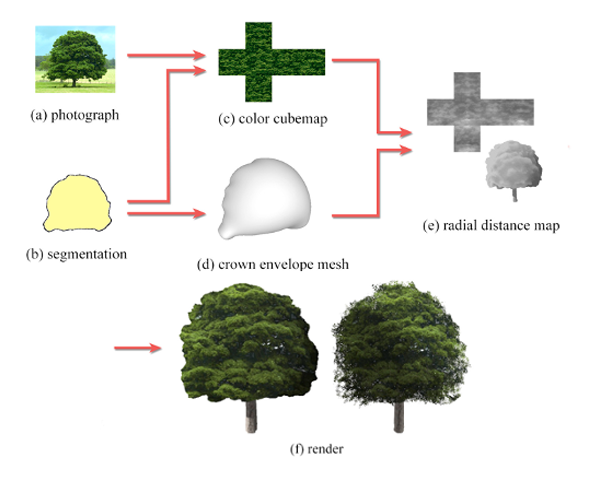
Single-picture reconstruction and rendering of trees for plausible vegetation synthesis
Computers & Graphics, Vol. 57, pp 55--67, 2016.
DOI: http://dx.doi.org/10.1016/j.cag.2016.03.005
DOI: http://dx.doi.org/10.1016/j.cag.2016.03.005
BibTeX

State-of-the-art approaches for tree reconstruction either put limiting constraints on the input side (requiring multiple photographs, a scanned point cloud or intensive user input) or provide a representation only suitable for front views of the tree. In this paper we present a complete pipeline for synthesizing and rendering detailed trees from a single photograph with minimal user effort. Since the overall shape and appearance of each tree is recovered from a single photograph of the tree crown, artists can benefit from georeferenced images to populate landscapes with native tree species. A key element of our approach is a compact representation of dense tree crowns through a radial distance map. Our first contribution is an automatic algorithm for generating such representations from a single exemplar image of a tree. We create a rough estimate of the crown shape by solving a thin-plate energy minimization problem, and then add detail through a simplified shape-from-shading approach. The use of seamless texture synthesis results in an image-based representation that can be rendered from arbitrary view directions at different levels of detail. Distant trees benefit from an output-sensitive algorithm inspired on relief mapping. For close-up trees we use a billboard cloud where leaflets are distributed inside the crown shape through a space colonization algorithm. In both cases our representation ensures efficient preservation of the crown shape. Major benefits of our approach include: it recovers the overall shape from a single tree image, involves no tree modeling knowledge and minimal authoring effort, and the associated image-based representation is easy to compress and thus suitable for network streaming.

Computer Graphics Forum, Vol. 35, Num. 8, pp 32--50, 2016.
DOI: http://dx.doi.org/10.1111/cgf.12774
DOI: http://dx.doi.org/10.1111/cgf.12774
BibTeX

In this survey we review, classify and compare existing approaches for real-time crowd rendering. We first overview character animation techniques, as they are highly tied to crowd rendering performance, and then we analyze the state of the art in crowd rendering. We discuss different representations for level-of-detail (LoD) rendering of animated characters, including polygon-based, point-based, and image-based techniques, and review different criteria for runtime LoD selection. Besides LoD approaches, we review classic acceleration schemes, such as frustum culling and occlusion culling, and describe how they can be adapted to handle crowds of animated characters. We also discuss specific acceleration techniques for crowd rendering, such as primitive pseudo-instancing, palette skinning, and dynamic key-pose caching, which benefit from current graphics hardware. We also address other factors affecting performance and realism of crowds such as lighting, shadowing, clothing and variability. Finally we provide an exhaustive comparison of the most relevant approaches in the field.
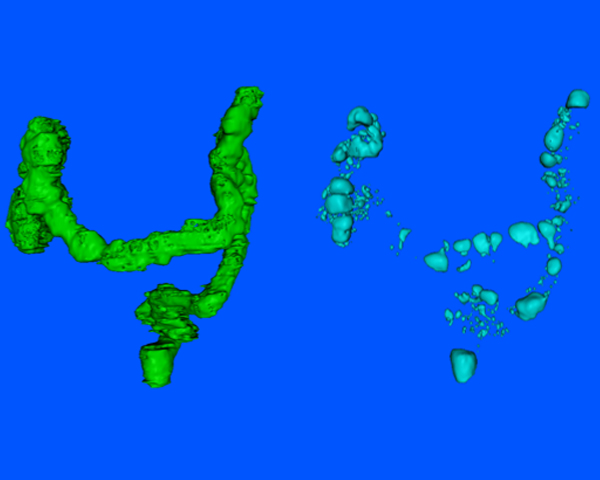
Colonic content in health and its relation to functional gut symptoms
Neurogastroenterology and Motility , Vol. 28, Num. 6, pp 849--854, 2016.
DOI: http://dx.doi.org/10.1111/nmo.12782
DOI: http://dx.doi.org/10.1111/nmo.12782
BibTeX

Background:
Gut content may be determinant in the generation of digestive symptoms, particularly in patients with impaired gut function and hypersensitivity. Since the relation of intraluminal gas to symptoms is only partial, we hypothesized that non-gaseous component may play a decisive role.
Methods:
Abdominal computed tomography scans were evaluated in healthy subjects during fasting and after a meal (n = 15) and in patients with functional gut disorders during basal conditions (when they were feeling well) and during an episode of abdominal distension (n = 15). Colonic content and distribution were measured by an original analysis program.
Key results:
In healthy subjects both gaseous (87 ± 24 mL) and non-gaseous colonic content (714 ± 34 mL) were uniformly distributed along the colon. In the early postprandial period gas volume increased (by 46 ± 23 mL), but non-gaseous content did not, although a partial caudad displacement from the descending to the pelvic colon was observed. No differences in colonic content were detected between patients and healthy subjects. Symptoms were associated with discrete increments in gas volume. However, no consistent differences in non-gaseous content were detected in patients between asymptomatic periods and during episodes of abdominal distension.
Conclusions & inferences:
In patients with functional gut disorders, abdominal distension is not related to changes in non-gaseous colonic content. Hence, other factors, such as intestinal hypersensitivity and poor tolerance of small increases in luminal gas may be involved.
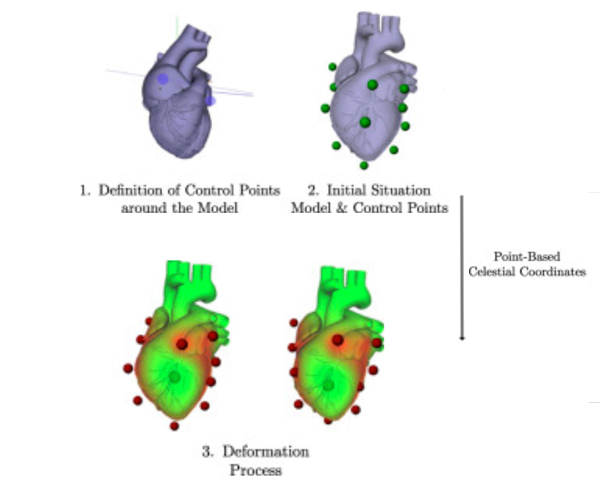
3D Model deformations with arbitrary control points
Computer & Graphics, Vol. 57, pp 92-101, 2016.
DOI: http://dx.doi.org/10.1016/j.cag.2016.03.010
DOI: http://dx.doi.org/10.1016/j.cag.2016.03.010
BibTeX

Cage-based space deformations are often used to edit and animate images and geometric models. The deformations of the cage are easily transferred to the model by recomputing fixed convex combinations of the vertices of the cage, the control points. In current cage-based schemes the configuration of edges and facets between these control points affects the resulting deformations. In this paper we present a family of similar schemes that includes some of the current techniques, but also new schemes that depend only on the positions of the control points. We prove that these methods afford a solution under fairly general conditions and result in an easy and flexible way to deform objects using freely placed control points, with the necessary conditions of positivity and continuity.
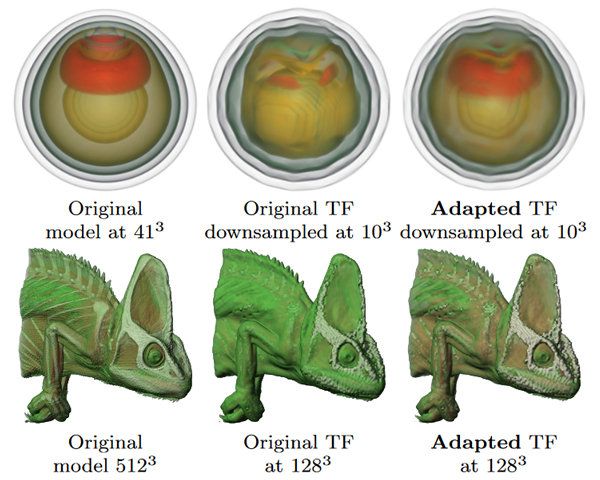
Computer Graphics International , Vol. 32, Num. 6, pp 835--845, 2016.
DOI: http://dx.doi.org/10.1007/s00371-016-1253-9
DOI: http://dx.doi.org/10.1007/s00371-016-1253-9
BibTeX

Medical datasets are continuously increasing in size. Although larger models may be available for certain research purposes, in the common clinical practice the models are usually of up to 512×512×2000 voxels. These resolutions exceed the capabilities of conventional GPUs, the ones usually found in the medical doctors’ desktop PCs. Commercial solutions typically reduce the data by downsampling the dataset iteratively until it fits the available target specifications. The data loss reduces the visualization quality and this is not commonly compensated with other actions that might alleviate its effects. In this paper, we propose adaptive transfer functions, an algorithm that improves the transfer function in downsampled multiresolution models so that the quality of renderings is highly improved. The technique is simple and lightweight, and it is suitable, not only to visualize huge models that would not fit in a GPU, but also to render not-so-large models in mobile GPUs, which are less capable than their desktop counterparts. Moreover, it can also be used to accelerate rendering frame rates using lower levels of the multiresolution hierarchy while still maintaining high-quality results in a focus and context approach. We also show an evaluation of these results based on perceptual metrics.
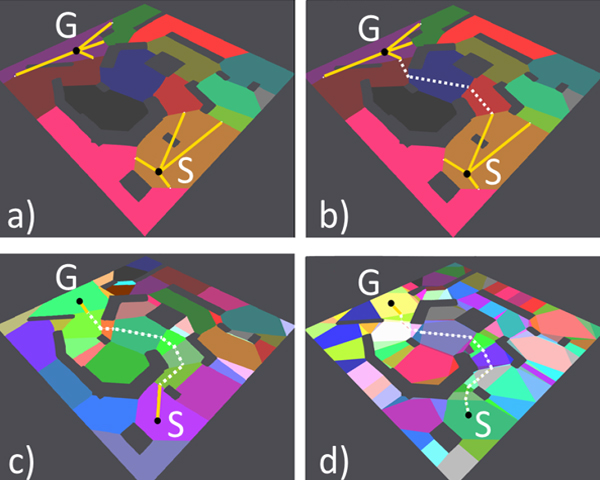
Computers & Graphics, Vol. 59, pp 68--78, 2016.
DOI: http://dx.doi.org/10.1016/j.cag.2016.05.023
DOI: http://dx.doi.org/10.1016/j.cag.2016.05.023
BibTeX

Path-finding can become an important bottleneck as both the size of the virtual environments and the number of agents navigating them increase. It is important to develop techniques that can be efficiently applied to any environment independently of its abstract representation. In this paper we present a hierarchical NavMesh representation to speed up path-finding. Hierarchical path-finding (HPA*) has been successfully applied to regular grids, but there is a need to extend the benefits of this method to polygonal navigation meshes. As opposed to regular grids, navigation meshes offer representations with higher accuracy regarding the underlying geometry, while containing a smaller number of cells. Therefore, we present a bottom-up method to create a hierarchical representation based on a multilevel k-way partitioning algorithm (MLkP), annotated with sub-paths that can be accessed online by our Hierarchical NavMesh Path-finding algorithm (HNA*). The algorithm benefits from searching in graphs with a much smaller number of cells, thus performing up to 7.7 times faster than traditional A⁎ over the initial NavMesh. We present results of HPA* over a variety of scenarios and discuss the benefits of the algorithm together with areas for improvement.

IADIS International Journal on Computer Science and Information Systems, Vol. 11, Num. 2, pp 1--18, 2016.
BibTeX

Despite the large amount of methods and applications of augmented reality, there is little homogenization on the software platforms that support them. An exception may be the low level control software that is provided by some high profile vendors such as Qualcomm and Metaio. However, these provide fine grain modules for e.g. element tracking. We are more concerned on the application framework, that includes the control of the devices working together for the development of the AR
experience. In this paper we describe the development of a software framework for AR setups. We concentrate on the modular design of the framework, but also on some hard problems such as the calibration stage, crucial for projection-based AR. The developed framework is suitable and has been tested in AR applications using camera-projector pairs, for both fixed and nomadic setups.
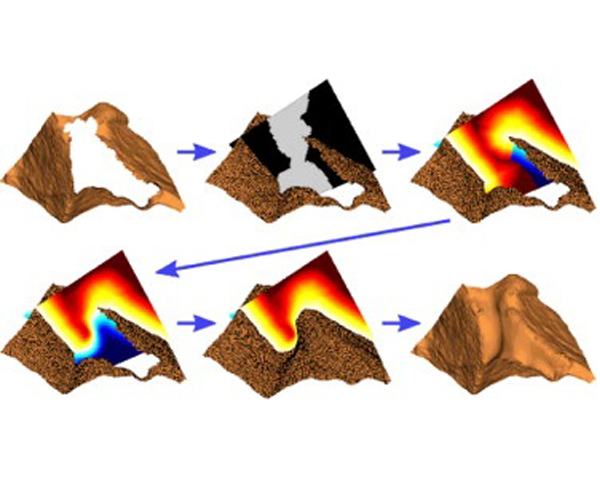
Graphical Models, Vol. 82, pp 137–148, 2015.
DOI: http://dx.doi.org/10.1016/j.gmod.2015.06.010
DOI: http://dx.doi.org/10.1016/j.gmod.2015.06.010
BibTeX

We discuss bi-harmonic fields which approximate signed distance fields. We conclude that the biharmonic field approximation can be a powerful tool for mesh completion in general and complex cases. We present an adaptive, multigrid algorithm to extrapolate signed distance fields. By defining a volume mask in a closed region bounding the area that must be repaired, the algorithm computes a signed distance field in well-defined regions and uses it as an over-determined boundary condition constraint for the biharmonic field computation in the remaining regions. The algorithm operates locally, within an expanded bounding box of each hole, and therefore scales well with the number of holes in a single, complex model. We discuss this approximation in practical examples in the case of triangular meshes resulting from laser scan acquisitions which require massive hole repair. We conclude that the proposed algorithm is robust and general, and is able to deal with complex topological cases.
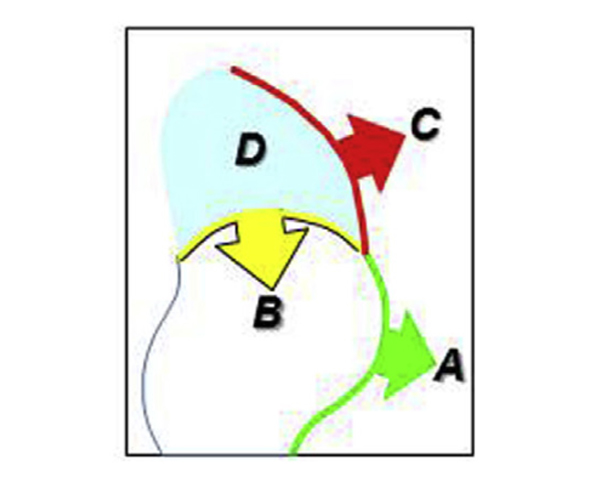
Gastroenterology, Vol. 148, Num. 4, pp 732--739, 2015.
DOI: http://dx.doi.org/10.1053/j.gastro.2014.12.006
PDF
DOI: http://dx.doi.org/10.1053/j.gastro.2014.12.006
BibTeX

Background and Aims:
In patients with functional gut disorders, abdominal distension has been associated with descent of the diaphragm and protrusion of the anterior abdominal wall. We investigated mechanisms of abdominal distension in these patients.
Methods:
We performed a prospective study of 45 patients (42 women, 24–71 years old) with functional intestinal disorders (27 with irritable bowel syndrome with constipation, 15 with functional bloating, and 3 with irritable bowel syndrome with alternating bowel habits) and discrete episodes of visible abdominal distension. Subjects were assessed by abdominothoracic computed tomography (n = 39) and electromyography (EMG) of the abdominothoracic wall (n = 32) during basal conditions (without abdominal distension) and during episodes of severe abdominal distension. Fifteen patients received a median of 2 sessions (range, 1–3 sessions) of EMG-guided, respiratory-targeted biofeedback treatment; 11 received 1 control session before treatment.
Results:
Episodes of abdominal distension were associated with diaphragm contraction (19% ± 3% increase in EMG score and 12 ± 2 mm descent; P < .001 vs basal values) and intercostal contraction (14% ± 3% increase in EMG scores and 6 ± 1 mm increase in thoracic antero-posterior diameter; P < .001 vs basal values). They were also associated with increases in lung volume (501 ± 93 mL; P < .001 vs basal value) and anterior abdominal wall protrusion (32 ± 3 mm increase in girth; P < .001 vs basal). Biofeedback treatment, but not control sessions, reduced the activity of the intercostal muscles (by 19% ± 2%) and the diaphragm (by 18% ± 4%), activated the internal oblique muscles (by 52% ± 13%), and reduced girth (by 25 ± 3 mm) (P ≤ .009 vs pretreatment for all).
Conclusions:
In patients with functional gut disorders, abdominal distension is a behavioral response that involves activity of the abdominothoracic wall. This distension can be reduced with EMG-guided, respiratory-targeted biofeedback therapy.

Computer & Graphics, Vol. 47, pp 105-112, 2015.
DOI: http://dx.doi.org/10.1016/j.cag.2014.12.004
PDF
DOI: http://dx.doi.org/10.1016/j.cag.2014.12.004
BibTeX

This paper presents a real-time animation system for fully-embodied virtual humans that satisfies accurate foot placement constraints
for different human walking and running styles. Our method offers a fine balance between motion fidelity and character
control, and can efficiently animate over sixty agents in real time (25 FPS) and over a hundred characters at 13 FPS. Given a
point cloud of reachable support foot configurations extracted from the set of available animation clips, we compute the Delaunay
triangulation. At runtime, the triangulation is queried to obtain the simplex containing the next footstep, which is used to compute
the barycentric blending weights of the animation clips. Our method synthesizes animations to accurately follow footsteps, and
a simple IK solver adjusts small offsets, foot orientation, and handles uneven terrain. To incorporate root velocity fidelity, the
method is further extended to include the parametric space of root movement and combine it with footstep based interpolation. The
presented method is evaluated on a variety of test cases and error measurements are calculated to offer a quantitative analysis of the
results achieved.
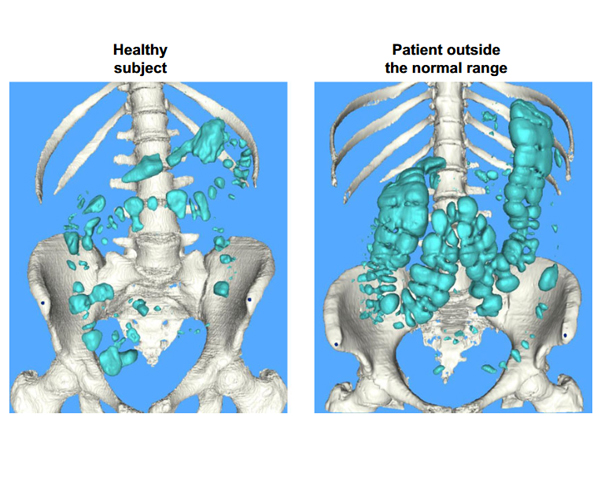
Neurogastroenterology and motility, Vol. 27, Num. 9, pp 1249--1257, 2015.
DOI: http://dx.doi.org/10.1111/nmo.12618
DOI: http://dx.doi.org/10.1111/nmo.12618
BibTeX

Background:
The precise relation of intestinal gas to symptoms, particularly abdominal bloating and distension remains incompletely elucidated. Our aim was to define the normal values of intestinal gas volume and distribution and to identify abnormalities in relation to functional‐type symptoms.
Methods:
Abdominal computed tomography scans were evaluated in healthy subjects (n = 37) and in patients in three conditions: basal (when they were feeling well; n = 88), during an episode of abdominal distension (n = 82) and after a challenge diet (n = 24). Intestinal gas content and distribution were measured by an original analysis program. Identification of patients outside the normal range was performed by machine learning techniques (one‐class classifier). Results are expressed as median (IQR) or mean ± SE, as appropriate.
Key Results:
In healthy subjects the gut contained 95 (71, 141) mL gas distributed along the entire lumen. No differences were detected between patients studied under asymptomatic basal conditions and healthy subjects. However, either during a spontaneous bloating episode or once challenged with a flatulogenic diet, luminal gas was found to be increased and/or abnormally distributed in about one‐fourth of the patients. These patients detected outside the normal range by the classifier exhibited a significantly greater number of abnormal features than those within the normal range (3.7 ± 0.4 vs 0.4 ± 0.1; p < 0.001).
Conclusions & Inferences:
The analysis of a large cohort of subjects using original techniques provides unique and heretofore unavailable information on the volume and distribution of intestinal gas in normal conditions and in relation to functional gastrointestinal symptoms.
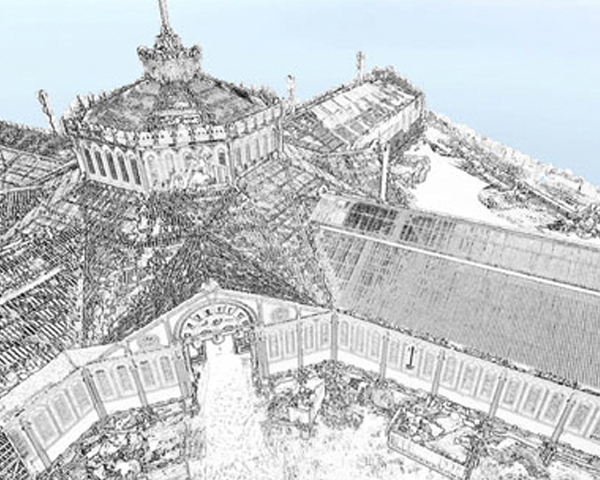
Immersive data comprehension: visualizing uncertainty in measurable models
Frontiers in Robotics and AI, Virtual Environments, pp 2-22, 2015.
DOI: http://dx.doi.org/10.3389/frobt.2015.00022
DOI: http://dx.doi.org/10.3389/frobt.2015.00022
BibTeX

Recent advances in 3D scanning technologies have opened new possibilities in a broad range of applications including cultural heritage, medicine, civil engineering, and urban planning. Virtual Reality systems can provide new tools to professionals that want to understand acquired 3D models. In this review paper, we analyze the concept of data comprehension with an emphasis on visualization and inspection tools on immersive setups. We claim that in most application fields, data comprehension requires model measurements, which in turn should be based on the explicit visualization of uncertainty. As 3D digital representations are not faithful, information on their fidelity at local level should be included in the model itself as uncertainty bounds. We propose the concept of Measurable 3D Models as digital models that explicitly encode such local uncertainty bounds. We claim that professionals and experts can strongly benefit from immersive interaction through new specific, fidelity-aware measurement tools, which can facilitate 3D data comprehension. Since noise and processing errors are ubiquitous in acquired datasets, we discuss the estimation, representation, and visualization of data uncertainty. We show that, based on typical user requirements in Cultural Heritage and other domains, application-oriented measuring tools in 3D models must consider uncertainty and local error bounds. We also discuss the requirements of immersive interaction tools for the comprehension of huge 3D and nD datasets acquired from real objects.
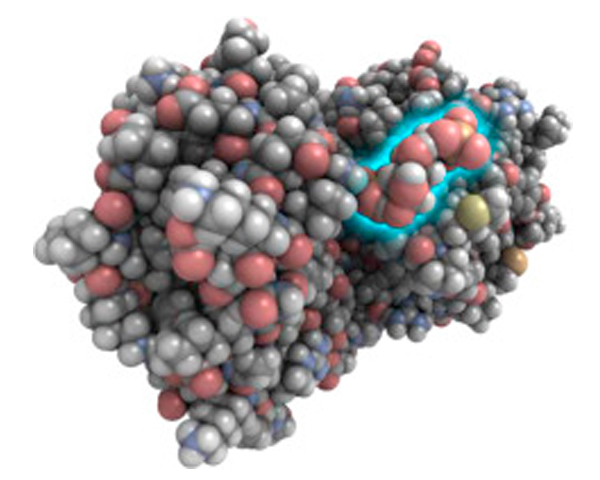
Computers & Graphics, Vol. 54, pp 113-120, 2015.
DOI: http://dx.doi.org/10.1016/j.cag.2015.07.017
DOI: http://dx.doi.org/10.1016/j.cag.2015.07.017
BibTeX

All-atom simulations are crucial in biotechnology. In Pharmacology, for example, molecular knowledge of protein-drug interactions is essential in the understanding of certain pathologies and in the development of improved drugs. To achieve this detailed information, fast and enhanced molecular visualization is critical. Moreover, hardware and software developments quickly deliver extensive data, providing intermediate results that can be analyzed by scientists in order to interact with the simulation process and direct it to a more promising configuration. In this paper we present a GPU-friendly data structure for real-time illustrative visualization of all-atom simulations. Our system generates both ambient occlusion and halos using an occupancy pyramid that needs no precalculation and that is updated on the fly during simulation, allowing the real time rendering of simulation results at sustained high framerates.

Computers & graphics, Vol. 47, pp 48--58, 2015.
DOI: http://dx.doi.org/10.1016/j.cag.2014.11.004
DOI: http://dx.doi.org/10.1016/j.cag.2014.11.004
BibTeX

There are two frequent artifacts in crowd simulation caused by navigation mesh design. The first appears when all agents attempt to traverse the navigation mesh and share the same way points through portals, thus increasing the probability of collisions with other agents or queues forming around portals. The second is caused by way points being assigned at locations where clearance is not guaranteed, which causes the agents to either walk too close to the static geometry, slide along walls or get stuck. To overcome this we use the full length of the portal and propose a novel method for dynamically calculating way points based on current trajectory, destination, and clearance, therefore guaranteeing that agents in a crowd will have different way points assigned. To achieve collision free paths we propose two novel techniques: the first provides the computation of paths with clearance for cells of any shape (even with concavities) and the second presents a new method for calculating portals with clearance, so that the dynamically assigned way points will always guarantee collision free paths relative to the static geometry. In this paper, we extend our previous work by describing a new version of the algorithm that is suitable for a larger number of navigation meshes, while further improving performance. Our results show how the combination of portals with exact clearance and dynamic way points improve local movement by reducing the number of collision between agents and the static geometry. We evaluate our algorithm with a variety of scenarios and compare our results with traditional way points to show that our technique also offers better use of the space by the agents.

Skeleton-driven animation is popular by its simplicity and intuitive control of the limbs of a character. Linear blend skinning (LBS) is up to date the most efficient and simple deformation method; however, painting influence skinning weights is
not intuitive, and it suffers the candy-wrapper artifact. In this paper, we propose an approach based on mesh segmentation
for skinning and skeleton-driven computer animation. We propose a novel and fast method, based in watershed segmentation to deal with characters in T-Pose and arbitrary poses, a simple weight assign algorithm based in the rigid skinning
obtained with the segmentation algorithm for the LBS deformation method, and finally, a modified version of the LBS that
avoids the loss of volume in twist rotations using the segmentation stage output values.

Real-Time Molecular Visualization Supporting Diffuse Illumination and Ambient Occlusion
IEEE Transactions on Visualization and Computer Graphics, Vol. 22, Num. 1, pp 718-27, 2015.
DOI: http://dx.doi.org/10.1109/TVCG.2015.2467293
DOI: http://dx.doi.org/10.1109/TVCG.2015.2467293
BibTeX

Today molecular simulations produce complex data sets capturing the interactions of molecules in detail. Due to the complexity of this time-varying data, advanced visualization techniques are required to support its visual analysis. Current molecular visualization techniques utilize ambient occlusion as a global illumination approximation to improve spatial comprehension. Besides these shadow-like effects, interreflections are also known to improve the spatial comprehension of complex geometric structures. Unfortunately, the inherent computational complexity of interreflections would forbid interactive exploration, which is mandatory in many scenarios dealing with static and time-varying data. In this paper, we introduce a novel analytic approach for capturing interreflections of molecular structures in real-time. By exploiting the knowledge of the underlying space filling representations, we are able to reduce the required parameters and can thus apply symbolic regression to obtain an analytic expression for interreflections. We show how to obtain the data required for the symbolic regression analysis, and how to exploit our analytic solution to enhance interactive molecular visualizations.
Gen3dlife Conferences Results
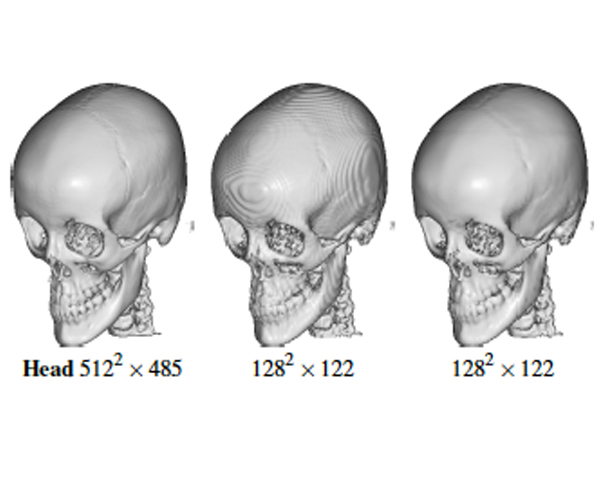
CEIG 2017:XXVII Spanish Computer Graphics Conference, pp 51--60, 2017.
DOI: http://dx.doi.org/10.2312/ceig.20171208
DOI: http://dx.doi.org/10.2312/ceig.20171208
BibTeX

The way in which gradients are computed in volume data-sets influences both the quality of the shading and the performance obtained in rendering algorithms. In particular, the visualization of coarse datasets in multi-resolution representations is affected when gradients are evaluated on-the-fly in the shader code by accessing neighbouring positions. We propose a downsampling filter for pre-computed gradients that provides improved gradients that better match the originals such that the aforementioned artifacts disappear. Secondly, to address the storage problem, we present a method for the efficient storage of gradient directions that is able to minimize the minimum angle achieved among all representable vectors in a space of 3 bytes.
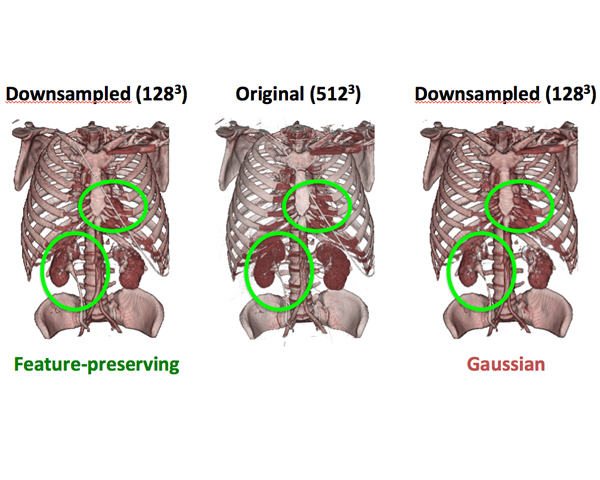
IADIS International Conference Computer Graphics, Visualization, Computer Vision and Image Processing-CGVCVIP, pp 12--20, 2017.
BibTeX

Volume visualization software usually has to deal with datasets that are larger than the GPUs may hold. This is especially true in one of the most popular application scenarios: medical visualization. In this paper we explore the quality of different downsampling methods and present a new approach that produces smooth lower-resolution representations, yet still preserves small features that are prone to disappear with other approaches.

CEIG 2017:XXVII Spanish Computer Graphics Conference, pp 19-22, 2017.
DOI: http://dx.doi.org/ http://dx.doi.org/10.2312/ceig.20171203
DOI: http://dx.doi.org/ http://dx.doi.org/10.2312/ceig.20171203
BibTeX

Skeleton tracking has multiple applications such as games, virtual reality, motion capture and more. One of the main challenges of pose detection is to be able to obtain the best possible quality with a cheap and easy-to-use device. In this work we propose a physically based method to detect errors and tracking issues which appear when we use low cost tracking devices such as Kinect. Therefore, we can correct the animation in order to obtain a smoother movement. We have implemented the Newton- Euler Algorithm, which allow us to compute the internal forces involved in a skeleton. In a common movement, forces are usually smooth without sudden variations. When the tracking yields poor results or invalid poses the internal forces become very large with a lot of variation. This allow us to detect when the tracking system fails and the animation needs to be inferred through different methods.
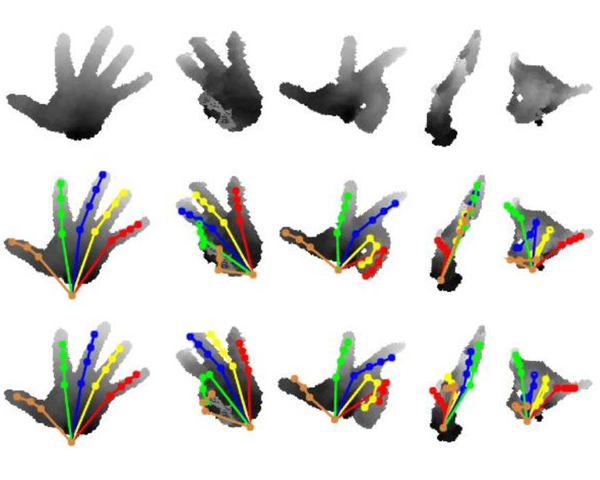
Occlusion aware hand pose recovery from sequences of depth images
12th IEEE International Conference on Automatic Face & Gesture Recognition (FG 2017), pp 230-237, 2017.
DOI: http://dx.doi.org/10.1109/FG.2017.37
DOI: http://dx.doi.org/10.1109/FG.2017.37
BibTeX

State-of-the-art approaches on hand pose estimation from depth images have reported promising results under quite controlled considerations. In this paper we propose a two-step pipeline for recovering the hand pose from a sequence of depth images. The pipeline has been designed to deal with images taken from any viewpoint and exhibiting a high degree of finger occlusion. In a first step we initialize the hand pose using a part-based model, fitting a set of hand components in the depth images. In a second step we consider temporal data and estimate the parameters of a trained bilinear model consisting of shape and trajectory bases. Results on a synthetic, highly-occluded dataset demonstrate that the proposed method outperforms most recent pose recovering approaches, including those based on CNNs.

10th ACM SIGGRAPH Conference on Motion in Games, pp 8:1-8:6, 2017.
DOI: http://dx.doi.org/10.1145/3136457.3136465
DOI: http://dx.doi.org/10.1145/3136457.3136465
BibTeX

The challenge of path-finding in video games is to compute optimal or near optimal paths as efficiently as possible. As both the size of the environments and the number of autonomous agents increase, this computation has to be done under hard constraints of memory and CPU resources. Hierarchical approaches, such as HNA* can compute paths more efficiently, although only for certain configurations of the hierarchy. For other configurations, performance can drop drastically when inserting the start and goal position into the hierarchy. In this paper we present improvements to HNA* to eliminate bottlenecks. We propose different methods that rely on further memory storage or parallelism on both CPU and GPU, and carry out a comparative evaluation. Results show an important speed-up for all tested configurations and scenarios.
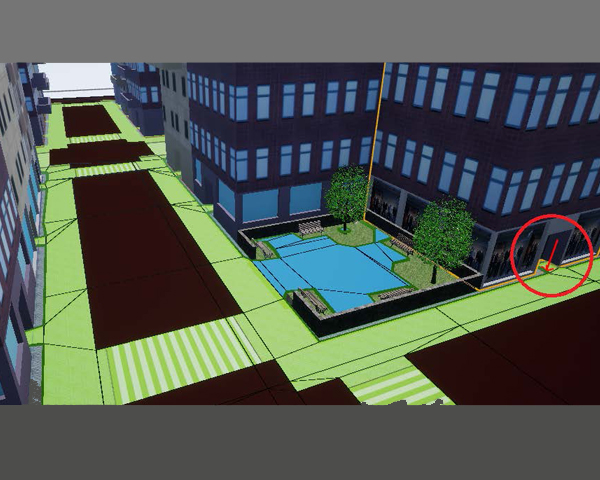
Spanish Computer Graphics Conference (CEIG), pp 113-120, 2017.
DOI: http://dx.doi.org/10.2312/ceig.20171217
DOI: http://dx.doi.org/10.2312/ceig.20171217
BibTeX

Procedural modeling of virtual cities has achieved high levels of realism with little effort from the user. One can rapidly obtain a large city using off-the-shelf software based on procedural techniques, such as the use of CGA. However in order to obtain realistic virtual cities it is necessary to include virtual humanoids that behave realistically adapting to such environment. The first step towards achieving this goal requires tagging the environment with semantics, which is a time consuming task usually done by hand. In this paper we propose a framework to rapidly generate virtual cities with semantics that can be used to drive the behavior of the virtual pedestrians. Ideally, the user would like to have some freedom between fully automatic generation and usage of pre-existing data. Existing data can be useful for two reasons: re-usability, and copying real cities fully or partly to develop virtual environments. In this paper we propose a framework to create such semantically augmented cities from either a fully procedural method, or using data from OpenStreetMap. Our framework has been integrated with Unreal Engine 4.
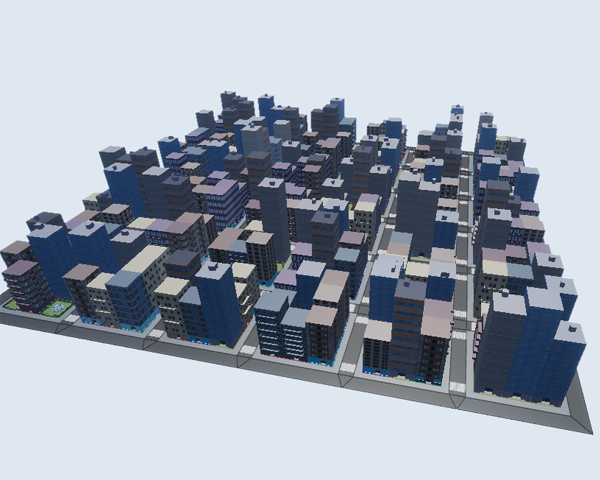
Authoring Semantic Procedural Cities
10th ACM SIGGRAPH Conference on Motion in Games - Posters, pp 1, 2017.
BibTeX


EuroVis 2017 - 19th EG/VGTC Conference on Visualization (Poster), 2017.
DOI: http://dx.doi.org/10.2312/eurp.20171184
DOI: http://dx.doi.org/10.2312/eurp.20171184
BibTeX

The analysis of the morphology and content of the gut is necessary in order to understand metabolic and functional gut activity and for diagnostic purposes. Magnetic resonance imaging (MRI) has become an important modality technique since it is able to visualize soft tissues using no ionizing radiation, and hence removes the need for any contrast agents. In the last few years, MRI of gastrointestinal function has advanced substantially, although scarcely any publication has been devoted to the analysis of the colon content. This paper presents a semi-automatic segmentation tool for the quantitative assessment of the unprepared colon from MRI images. This application has allowed for the analysis of the colon content in various clinical experiments. The results of the assessment have contributed to a better understanding of the functionality of the colon under different diet conditions. The last experiment carried out by medical doctors showed a marked influence of diet on colonic content, accounting for about 30% of the volume variations.
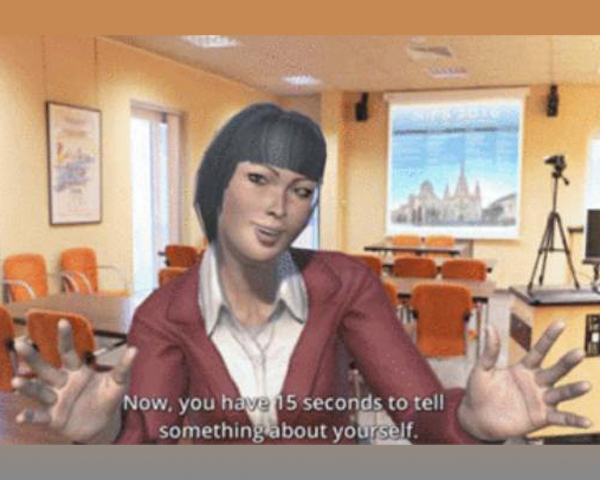
Automatic prediction of personality traits is a subjective task that has recently received much attention. Specifically, automatic apparent personality trait prediction from multimodal data has emerged as a hot topic within the filed of computer vision and, more particularly, the so called "looking at people" sub-field. Considering "apparent" personality traits as opposed to real ones considerably reduces the subjectivity of the task. The real world applications are encountered in a wide range of domains, including entertainment, health, human computer interaction, recruitment and security. Predictive models of personality traits are useful for individuals in many scenarios (e.g., preparing for job interviews, preparing for public speaking). However, these predictions in and of themselves might be deemed to be untrustworthy without human understandable supportive evidence. Through a series of experiments on a recently released benchmark dataset for automatic apparent personality trait prediction, this paper characterizes the audio and visual information that is used by a state-of-the-art model while making its predictions, so as to provide such supportive evidence by explaining predictions made. Additionally, the paper describes a new web application, which gives feedback on apparent personality traits of its users by combining model predictions with their explanations.
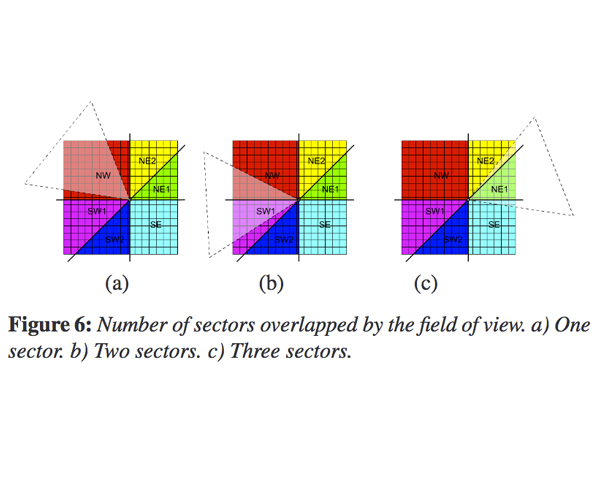
Ordering Triangles in Triangulated Terrains Over Regular Grids
In this work we report on a set of rules to visit triangles in
triangulated height fields defined over regular grids in a
back-to-front order with respect to an arbitrary viewpoint.
With the viewpoint, we associate an axis-alligned local reference
framework. Projections on the $XY$ plane of the local axis and the
bisector of the first and third quadrants define six sectors.
Specific visiting rules for collections of triangles that project on
each sector are then defined.
The experiments conducted show that the implementation of a simple
algorithm based on the set of visiting rules defined allows real time
interaction when the viewing position moves along an arbitrary 3D
path.

Human-Document Interaction systems - a new frontier for document image analysis
Proceedings of the International Workshop on Document Analysis Systems (DAS), 2016.
BibTeX

All indications show that paper documents will not cede in favour of their digital counterparts, but will instead be used increasingly in conjunction with digital information. An open challenge is how to seamlessly link the physical with the digital -how to continue taking advantage of the important affordances of paper, without missing out on digital functionality. This paper presents the authors’ experience with developing systems for Human-Document Interaction based on augmented document interfaces and examines new challenges and opportunities arising for the document image analysis field in this area. The system presented combines state of the art camera-based document image analysis techniques with a range of complementary technologies to offer fluid Human-Document Interaction. Both fixed and nomadic setups are discussed that have gone through user testing in real-life environments, and use cases are presented that span the spectrum from business to educational applications.

Optimized Skin Rendering for Scanned Models
Proceedings of the WSCG International Conferences in Central Europe on Computer Graphics, Visualization and Computer Vision, pp 89--96, 2016.
PDF
BibTeX

Skin is one of the most difficult materials to reproduce in computer graphics, mainly due to two major factors: First, the complexity of the light interactions happening at the subsurface layers of skin, and second, the high sensitivity of our perceptual system to the artificial imperfections commonly appearing in synthetic skin models. Many current approaches mix physically-based algorithms with image-based improvements to achieve realistic skin rendering in realtime. Unfortunately, those algorithms still suffer from artifacts such as halos or incorrect diffusion. Some of these artifacts (e.g. incorrect diffusion) are especially noticeable if the models have not been previously segmented. In this paper we present some extensions to the Separable Subsurface Scattering (SSSS) framework that reduce those artifacts while still maintaining a high framerate. The result is an improved algorithm that achieves high quality rendering for models directly obtained from scanners, not requiring
further processing.
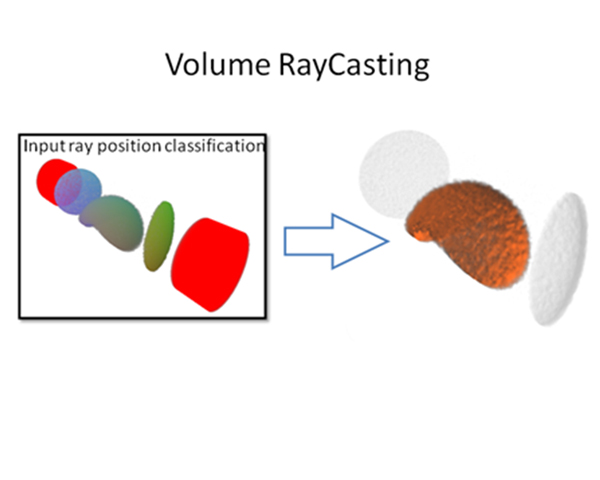
Enhanced Magnification for Reduced Movement in Virtual Reality Environments
International Conference on Computer Graphics, Visualization, Computer Vision and image Processing (IADIS'16), pp 149--156, 2016.
BibTeX

Although Virtual Reality (VR) environments have seen slower adoption rates than expected among the medical community, throughout the last years, several new techniques and devices (e.g. Oculus Rift) have been developed that might boost the popularity of VR. However, the use of 3D environments is not exempt of some shortcomings, such as the difficulties of adaption to 3D, that sometimes produces motion sickness, or the increase in effort the user has to undergo when interacting with a 3D system, as compared to using a simple mouse on a desktop. Our proposal is tailored to focus on the second problem. More concretely, we propose a magnification technique that is able to reduce the movements required to explore a concrete part of a volumetric dataset as compared to other zooming techniques. Our technique, builds the zooming result in the same virtual position of the initial interaction while still maintaining a contextual view on the region of interest and its surroundings. This way, the user reduces the amount of movements required to explore a model and efficiency is increased. An informal user study was carried out that confirmed our hypotheses.

IEEE VR Workshop on Virtual Humans and Crowds for Immersive Environment. VHCIE, 2016.
BibTeX

With advances in virtual reality technology and its multiple applica-tions, the need for believable, immersive virtual environments is in-creasing. Even though current computer graphics methods allow usto develop highly realistic virtual worlds, the main element failingto enhance presence is autonomous groups of human inhabitants.A great number of crowd simulation techniques have emerged inthe last decade, but critical details in the crowds movements andappearance do not meet the standards necessary to convince VRparticipants that they are present in a real crowd. In this paper, wereview recent advances in the creation of immersive virtual crowdsand discuss areas that require further work to turn these simulationsinto more fully immersive and believable experiences.

A software framework for the development of projection-based Augmented Reality Systems
IADIS Computer Graphics, Visualization, Computer Vision and Image Processing, 2016.
BibTeX

Despite the large amount of methods and applications of augmented reality, there is little homogenization on the software platforms that support them. An exception may be the low level control software that is provided by some high profile vendors such as Qualcomm and Metaio. However, these provide fine grain modules for e.g. element tracking. We are more concerned on the application framework, that includes the control of the devices working together for the development of the AR experience. In this paper we present a soft-
ware framework that can be used for the development of AR applications based on camera-projector pairs, that is suitable for both fixed, and nomadic setups.
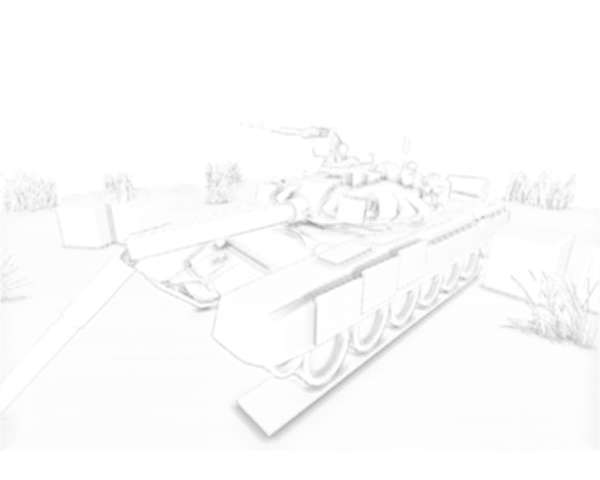
Screen space ambient occlusion is a popular dynamic global illumination technique that has seen widespread adoption in PC computer games and other applications due to its simplicity, scalability, and ability to be integrated with other techniques. Mobile platforms, however, have traditionally been unable to run screen space ambient occlusion and other global illumination techniques in real-time, forcing developers to bake most of the illumination as a consequence. In this paper, we analyze the technical aspects involved in porting Ambient Occlusion to mobile devices and propose an optimized pipeline that is able to improve Ambient Occlusion calculation in OpenGL-based pipelines. We demonstrate our optimizations by applying them to four popular techniques: Crytek, Starcraft, Alchemy, and Horizon-Based Ambient Occlusion.

Parallel GPU Collision Computation in Conformal Warped Space For Surface Detail Haptic
13th International Congress on Numerical Methods in Engineering and Applied Sciences, 2016.
BibTeX

Introducing a parallel collision computation procedure in GPU for rendering accurate touch sensation in highly complex geometric models. An objects geometry is covered completely by a connected mesh of edge-joined prismoids, while surface detail is encoded by an image-based approach in a special tangent space flat texture containing relief and surface normals values. Heights and normals within each prism are warped from object volume space to orthogonal tangent space, by means fast method for computing barycen-tric coordinates, and stored in a per-face sorted RGBA texture. Parallel computation is performed in GPU for many prisms at once. Applying a unified treatment of col lision detection in conformal space from euclidean 3 (3D) to a higher dimensional conformal space 4,1 (5D), CUDA core kernels perform parallel real-time collision detection in GPU, with a haptic probes position vector without any bounding volume prefiltering, to identify which prisms of the objects surface are being touched, and then map coordinates to tangent space, sampling relative surface height and normal from texture, for a final decision on whether the surface was hit. Results show throughput is increased between one and two orders of magnitude in collision benchmarks among known mesh models, computed in blind all vs. all manner, accurately colliding against 3D surface detail at high sampling rates without degrading touch sensation.
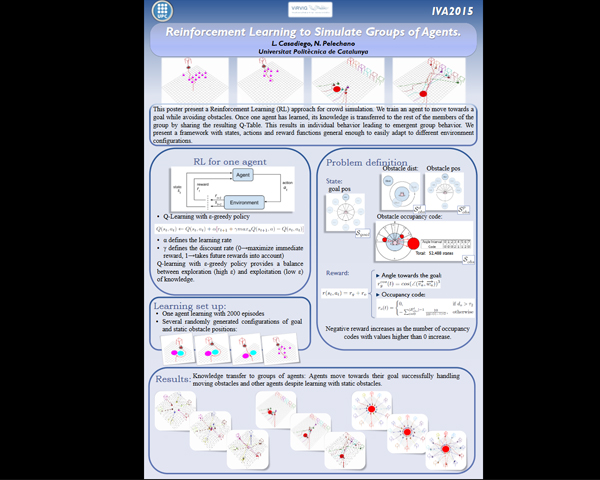
From One to Many:Simulating Groups of Agents with Reinforcement Learning Controllers
This
poster
present
a
Reinforcement
Learning
(RL)
approach
for
crowd
simulation
.
We
train
an
agent
to
move
towards
a
goal
while
avoiding
obstacles
.
Once
one
agent
has
learned,
its
knowledge
is
transferred
to
the
rest
of
the
members
of
the
group
by
sharing
the
resulting
Q
-
Table
.
This
results
in
individual
behavior
leading
to
emergent
group
behavior
.
We
present
a
framework
with
states,
actions
and
reward
functions
general
enough
to
easily
adapt
to
different
environment
configurations
.

DAPS for Degenerate Elements in FEM Simulations
Symposium Geometry Processing, 2015.
BibTeX

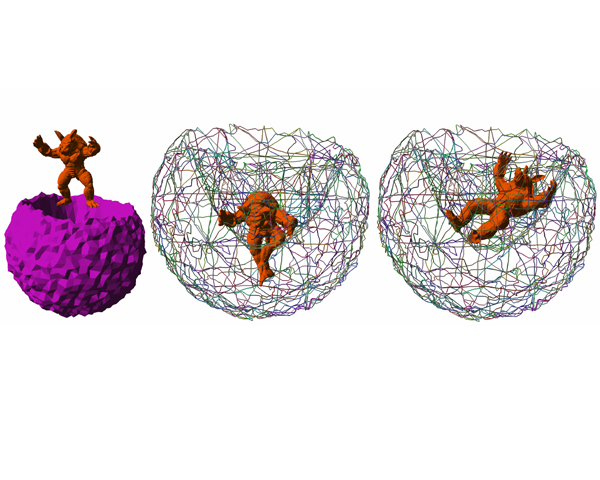
Fast Contact Determination for Intersecting Deformable Solids
In Proc. of Motion in Games (MIG'15), pp 205-214, 2015.
BibTeX

We present a fast contact determination scheme for intersecting deformable solids with detailed surface geometry. Given a high resolution closed surface mesh we automatically build a coarse embedding tetrahedralization and a partitioned representation of the surface in a preprocess. During simulation, the contact determination algorithm finds all intersecting pairs of deformed triangles using a memory-efficient barycentric bounding volume hierarchy, connects them into potentially disjoint intersection curves and performs a topological flood process on the exact intersection surfaces to discover a minimal set of contact points. A unique contact normal is computed for each contact volume, based on a continuous definition of surface normals, and used to find contact point correspondences suitable for contact treatment. The algorithm is strongly output-sensitive and we demonstrate robust contact determination at 60 frames per second for a pair of objects with 100K triangles in shallow intersecting contact.
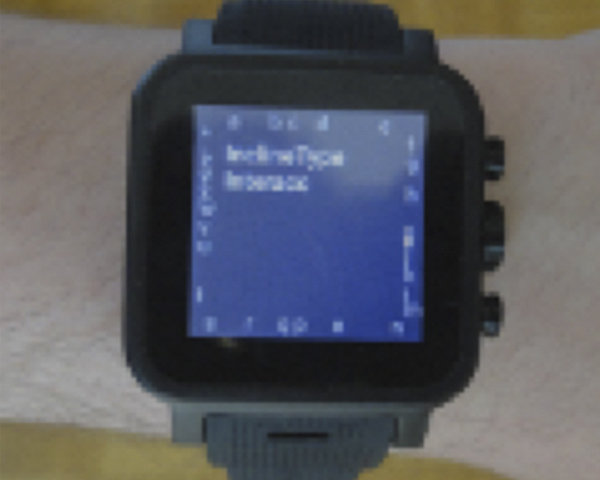
InclineType: An Accelerometer-based Typing Approach for Smartwatches
Proc. of XVI International Conference on Human Computer Interaction, pp 59:1-59:4, 2015.
BibTeX

Small mobile devices such as smartwatches are a rapidly growing market. However, they share the issue of limited input and output space which could impede the success of these devices in future. Hence, suitable alternatives to the concepts and metaphors known from smartphones have to be found. In this paper we present InclineType a tilt-based keyboard input that uses a 3-axis accelerometer for smartwatches. The user may directly select letters by moving his/her wrist and enters them by tapping on the touchscreen. Thanks to the distribution of the letters on the edges of the screen, the keyboard dedicates a low amount of space in the smartwatch. In order to optimize the user input our concept proposes multiple techniques to stabilize the user interaction. Finally, a user study shows that users get familiar with this technique with almost no previous training, reaching speeds of about 6 wpm in average.

Instant Visualization of Secondary Structures of Molecular Models
In Proc. of Eurographics Workshop on Visual Computing for Biology and Medicine, pp 51-60, 2015.
DOI: http://dx.doi.org/10.2312/vcbm.20151208
DOI: http://dx.doi.org/10.2312/vcbm.20151208
BibTeX

Molecular Dynamics simulations are of key importance in the drug design field. Among all possible representations commonly used to inspect these simulations, Ribbons has the advantage of giving the expert a good overview of the conformation of the molecule. Although several techniques have been previously proposed to render ribbons, all of them have limitations in terms of space or calculation time, making them not suitable for real-time interaction with simulation software. In this paper we present a novel adaptive method that generates ribbons in real-time, taking advantage of the tessellation shader. The result is a fast method that requires no precomputation, and that generates high quality shapes and shading.

XXV Spanish Computer Graphics Conference, pp 61-70, 2015.
DOI: http://dx.doi.org/10.2312/ceig.20151201
DOI: http://dx.doi.org/10.2312/ceig.20151201
BibTeX

Nowadays, an increasing interest on tele-medicine and tele-diagnostic solutions can be observed, with client/server architectures for remote inspection of volume image-based medical data which are becoming more and more popular. The use of portable devices is gradually spreading due to their portability and easy maintenance. In this paper, we present an efficient data model for segmented volume models based on a hierarchical data structure of surfels per anatomical structure. Surfel Octrees are compact enough for transmission through networks with limited bandwidth, and provide good visual quality in the client devices at a limited footprint. Anatomy atlases are represented as octree forests, supporting local interaction in the client device and selection of groups of medical organs. After presenting the octree generation and interaction algorithms, we present several examples and discuss the interest of the proposed approach in low-end devices such as mobiles and tablets
Gen3dlife PhD Thesis Results
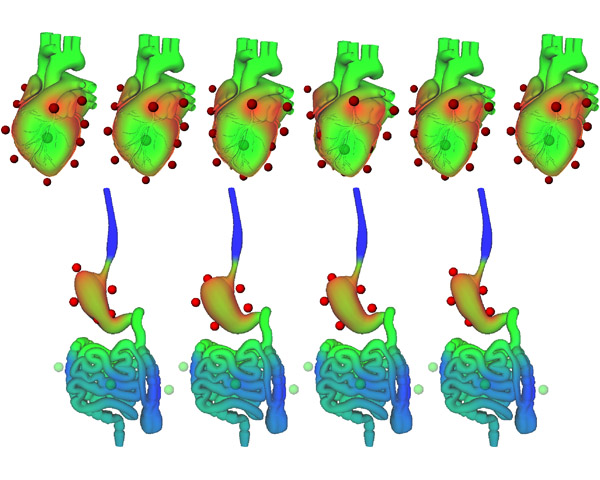
On Some Interactive Mesh Deformations
PhD. Thesis. January 2016.
Advisors: Brunet, Pere; Vinacua, Àlvar
BibTeX

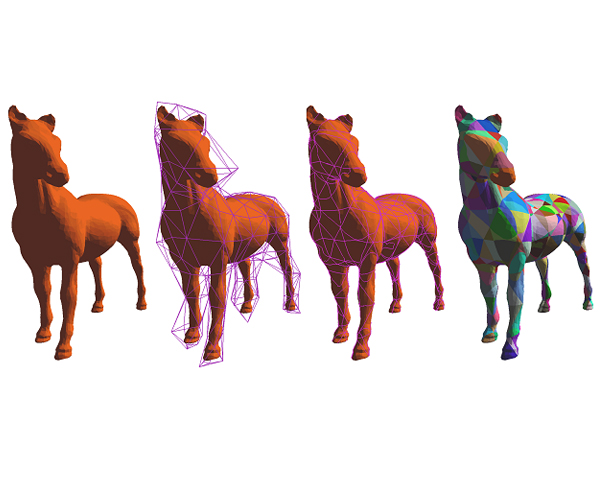
PhD. Thesis. February 2016.
Advisors: Susin, Antonio
BibTeX


PhD. Thesis. February 2016.
Advisors: Susin, Antonio
BibTeX

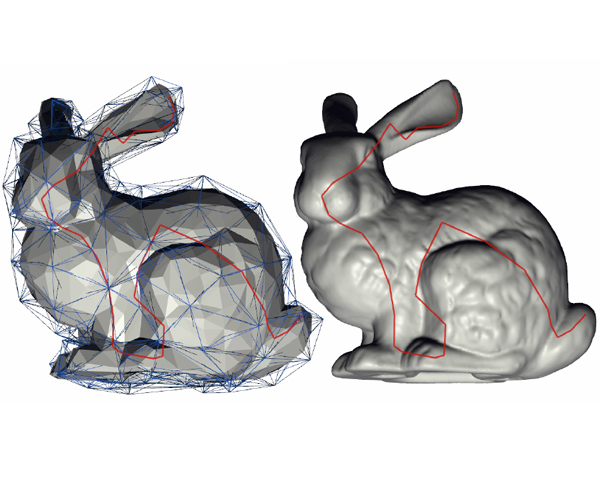
Enhancing detailed haptic relief for real-time interaction
PhD. Thesis. November 2015.
Advisors: Fairén, Marta; Navazo, Isabel
BibTeX
